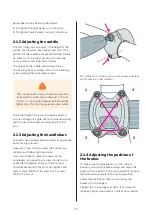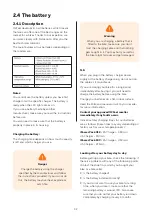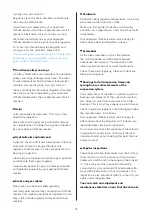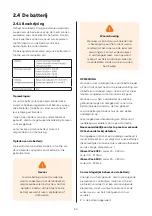
37
broken rim can cause serious accidents. Stop
riding the bike if you notice any changes to the
rim. Ask your approved O2Feel reseller to check
the damaged rim.
The rims on bikes bigger than 24” are equipped
with a wear indicator. A characteristic line can be
found on the side of the rim, or there will be a
groove all around the rim.
Replace the rim as soon as you notice any marks
(grooves, coloured areas) anywhere on the rim, or
if an engraved marking disappears or any coloured
writing becomes worn.
If the wear indicator is a groove or several points
on the side of the rim, replace the rim as soon as
these marks disappear.
Tyres
There are lots of different kinds of tyres. Their
properties and their rolling resistance depends on
their profile.
Do not exceed the stipulated inflation pressure for
the tyre. If you do, the tyre could burst.
Pump air into the tyre to achieve at least the
recommended minimum inflation pressure. If the
pressure is too low, the tyre could come away
from the rim.
The maximum and minimum inflation pressures
are usually indicated on the side of the tyre.
When changing tyres, only use the same kind
of tyre, with the same dimensions and the same
profile. Using different tyres may have a negative
effect on the handling characteristics of your bike.
This will potentially result in an accident.
Tyres are subject to wear. Check the tread,
pressure and condition of the sides of your tyres
regularly. Replace worn tyres before using your
bike.
Make sure you respect the dimensions of the
fitted tyre. They are indicated by standardised
references.
•
Example 1: “46-622” indicates that the width of
the tyre is 46mm and the diameter of the rim is
622mm
•
Example 2: “28 x 1.6 inches” indicates that the
diameter of the tyre is 28 inches and the width
is 1.6 inches.
Removing the wheels
Please note that the instructions provided here are
only examples. Make sure you respect the relevant
manufacturer’s guidelines or talk to your approved
O2Feel reseller.
Removing the front wheel
•
If your bike is equipped with quick releases,
unscrew them according to the manufacturer’s
instructions.
•
If your bike is equipped with axle nuts, unscrew
them with a suitable spanner by turning anti-
clockwise.
•
If the front wheel is protected against being
unscrewed thanks to the particular shape of
the derailleur hangers, continue to unscrew the
nuts by turning them anti-clockwise. When the
washers and the nuts are no longer touching
the derailleur hangers, remove the front wheel
from the fork.
Removing the rear wheel
•
If your bike is equipped with a rear derailleur,
position it on the smallest cog. In this position,
the gear changing mechanism will not get in the
way of removing the wheel.
•
If your bike is equipped with quick releases,
unscrew them.
•
If your bike is equipped with axle nuts, unscrew
them with a suitable spanner by turning anti-
clockwise.
•
Pull the gear shift mechanism back slightly.
•
Raise the bike a bit.
•
Remove the wheel from the frame.
•
If you cannot remove the rear wheel yet,
continue to open the quick release by turning
the locknut anti-clockwise.
•
Give the top part of the wheel a slight tap with
the palm of your hand.
•
The wheel will come away.
Содержание iSwan City
Страница 67: ......
Страница 110: ...O2Feel Bikes bonjour o2feel com www o2feel com ...
















































